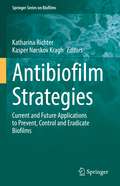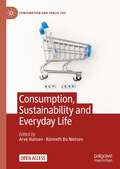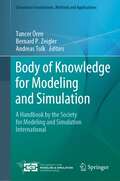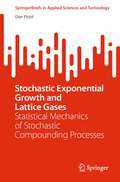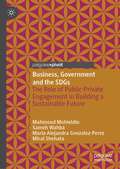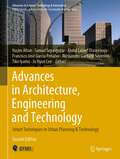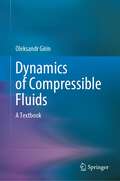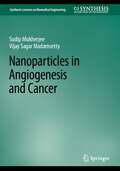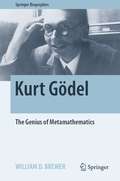- Table View
- List View
Point Cloud Technologies for Geomorphologists: From Data Acquisition to Processing (Springer Textbooks in Earth Sciences, Geography and Environment)
by Christopher GomezStarting from concrete examples in Geomorphology, this comprehensive textbook explains to graduate and postgraduate students, point-cloud data technology and associated methods from acquisition to final-product generation. In the last few decades, Geo-sciences have experienced a paradigm shift from the challenge of collecting enough data to the need of creating new processing tools that can handle the billions of data. This shift has come to Geomorphology with the increasing use of surface-pointclouds obtained from photogrammetry, laser scanners and processed by specialist software, and it is thus necessary for the next generation of geomorphologist to be fluent in these technologies. Consequently, this book explains from concrete examples how to use pointcloud technologies, from data collection to processing and final product generation. The philosophy of this book relies on two principles, first: you do not have to be a tech-wizard to use pointcloud technologies, allowing the you to bring back the focus on your science; second pointcloud methods can be affordable, therefore the book provide a set of worked-examples in the different geomorphological environments using open source software and R and Python code samples. The book can be used as a textbook in a geomorphology, geology, physical geography, Sabo-sciences and engineering class, as well as a companion for the more seasoned scientist who wants to solve specific problems.
Angle-Resolved Photoemission Spectroscopy Study of Spin Fluctuations in the Cuprate Superconductors (Springer Theses)
by Francisco RestrepoThis thesis makes significant advances towards an understanding of superconductivity in the cuprate family of unconventional, high-temperature superconductors. Even though the high-temperature superconductors were discovered over 35 years ago, there is not yet a general consensus on an acceptable theory of superconductivity in these materials. One of the early proposals suggested that collective magnetic excitations of the conduction electrons could lead them to form pairs, which in turn condense to form the superconducting state at a critical temperature Tc. Quantitative calculations of Tc using experimental data were, however, not available to verify the applicability of this magnetic mechanism. In this thesis, the author constructed an angle-resolved photoemission apparatus that could provide sufficiently accurate data of the electronic excitation spectra of samples in the normal state, data which was furthermore unusually devoid of any surface contamination. The author also applied the Bethe-Salpeter method to his uncommonly pristine and precise normal state data, and was able to predict the approximate superconducting transition temperatures of different samples. This rare combination of experiment with sophisticated theoretical calculations leads to the conclusion that antiferromagnetic correlations are a viable candidate for the pairing interaction in the cuprate superconductors.
Antibiofilm Strategies: Current and Future Applications to Prevent, Control and Eradicate Biofilms (Springer Series on Biofilms #11)
by Katharina Richter Kasper Nørskov KraghBacteria and fungi are able to aggregate together or on surfaces in densely packed microcolonies, facilitated by extracellular polymeric substances for cell protection and stability. These biofilms have proven to be extremely hard to eradicate and remove once established. In chronic infections, this condition can result in a high degree of morbidity and mortality as regular antibiotic treatments are ineffective against biofilms. In industrial facilities, the formation of biofilms can ruin production and result in enormous financial losses. In this book, the current state of antibiofilm research is presented by experts from around the world. Novel, cutting-edge techniques and new optimized strategies based on established methods are discussed in chapters focused on biofilm prevention, treatment and control for the application in clinical, industrial and veterinary settings. Antibiofilm strategies, such as chemical and enzymatic treatments, surface modification and coatings, quorum sensing inhibition and dispersal induction, phage therapy, cold plasma treatment, hyperbaric oxygen treatment, and metal-based nanomedicine are covered, among many others. This book contributes to the UN’s Sustainable Development Goal 3: Good Health and Well-Being and is a valuable resource for healthcare professionals, microbiologists, academics and for educators to inform curricula of universities and colleges.
Modern Biostatistical Methods for Evidence-Based Global Health Research (Emerging Topics in Statistics and Biostatistics)
by Ding-Geng Din Chen Samuel O. M. Manda Tobias F. ChirwaThis book provides an overview of the emerging topics in biostatistical theories and methods through their applications to evidence-based global health research and decision-making. It brings together some of the top scholars engaged in biostatistical method development on global health to highlight and describe recent advances in evidence-based global health applications. The volume is composed of five main parts: data harmonization and analysis; systematic review and statistical meta-analysis; spatial-temporal modeling and disease mapping; Bayesian statistical modeling; and statistical methods for longitudinal data or survival data. It is designed to be illuminating and valuable to both expert biostatisticians and to health researchers engaged in methodological applications in evidence-based global health research. It is particularly relevant to countries where global health research is being rigorously conducted.
Terminology, Ontology and their Implementations (Health Informatics)
by Peter L. ElkinThis revised new edition containing numerous new and heavily updated chapters provides readers with the essential information needed to understand the central topics of terminology in healthcare, the understanding of which is an asset to be leveraged in care and research. Twenty-five years ago the notion that terminology should be concept-based was all but unknown in healthcare; now almost all important terminologies are at least partly concept-based. With no general model of what a terminology was or should be, there were no tools to support terminology development and maintenance. Steady progress since then has improved both terminology content and the technology and processes used to sustain that content. This new edition uses real world examples from the health sector to delineate the principal issues and solutions for the field of data representation. It includes a history of terminologies and in particular their use in healthcare, including inter-enterprise clinical and research data aggregation. Terminology, Ontology and their Implementations covers the basis, authoring and use of ontologies and reference terminologies including the formalisms needed to use them safely. The editor and his team of carefully chosen contributors exhaustively reviews the field of concept-based indexing and provides readers with an understanding of natural language processing and its application to health terminologies. The book discusses terminology services and the architecture for terminological servers and consequently serves as the basis for study for all students of health informatics.
Consumption, Sustainability and Everyday Life (Consumption and Public Life)
by Arve Hansen Kenneth Bo NielsenThis open access book seeks to understand why we consume as we do, how consumption changes, and why we keep consuming more and more, despite the visible damage we are doing to the planet. The chapters cover both the stubbornness of unsustainable consumption patterns in affluent societies and the drivers of rapidly increasing consumption in emerging economies. They focus on consumption patterns with the largest environmental footprints, including energy, housing, and mobility and engage in sophisticated ways with the theoretical frontiers of the field of consumption research, in particular on the ‘practice turn’ that has come to dominate the field in recent decades. This book maps out what we know about consumption, questions what we take for granted, and points us in new directions for better understanding—and changing—unsustainable consumption patterns.
Indexing of Crystal Diffraction Patterns: From Crystallography Basics to Methods of Automatic Indexing (Springer Series in Materials Science #326)
by Adam MorawiecThis book provides a detailed, self-contained description of automatic indexing of crystal diffraction patterns, considering both ab initio indexing and indexing of patterns originating from known structures. Introductory chapters equip the reader with the necessary basic knowledge of geometric crystallography, as well as kinematic and dynamic theories of crystal diffraction. Subsequent chapters delve and describe ab initio indexing of single crystal diffraction patterns and indexing of patterns for orientation determination. The book also reviews methods of indexing powder diffraction and electron spot-type patterns, as well the subject of multigrain indexing. Later chapters are devoted to diffraction by helical structures and quasicrystals, as well as some aspects of lattice parameter refinement and strain determination.The book is intended equally for materials scientists curious about ‘nuts and bolts’ of diffraction pattern indexing and orientation mapping systems, as well as interdisciplinary researchers from physics, chemistry, and biology involved in crystallographic computing. It provides a rigorous, yet accessible, treatment of the subject matter for graduate students interested in understanding the functioning of diffraction pattern indexing engines.
Body of Knowledge for Modeling and Simulation: A Handbook by the Society for Modeling and Simulation International (Simulation Foundations, Methods and Applications)
by Tuncer Ören Bernard P. Zeigler Andreas TolkCommissioned by the Society for Modeling and Simulation International (SCS), this needed, useful new ‘Body of Knowledge’ (BoK) collects and organizes the common understanding of a wide collection of professionals and professional associations.Modeling and simulation (M&S) is a ubiquitous discipline that lays the computational foundation for real and virtual experimentation, clearly stating boundaries—and interactions—of systems, data, and representations. The field is well known, too, for its training support via simulations and simulators. Indeed, with computers increasingly influencing the activities of today’s world, M&S is the third pillar of scientific understanding, taking its place along with theory building and empirical observation.This valuable new handbook provides intellectual support for all disciplines in analysis, design and optimization. It contributes increasingly to the growing number of computational disciplines, addressing the broad variety of contributing as well as supported disciplines and application domains. Further, each of its sections provide numerous references for further information. Highly comprehensive, the BoK represents many viewpoints and facets, captured under such topics as:Mathematical and Systems Theory FoundationsSimulation Formalisms and ParadigmsSynergies with Systems Engineering and Artificial IntelligenceMultidisciplinary ChallengesEthics and PhilosophyHistorical PerspectivesExamining theoretical as well as practical challenges, this unique volume addresses the many facets of M&S for scholars, students, and practitioners. As such, it affords readers from all science, engineering, and arts disciplines a comprehensive and concise representation of concepts, terms, and activities needed to explain the M&S discipline.Tuncer Ören is Professor Emeritus at the University of Ottawa. Bernard Zeigler is Professor Emeritus at the University of Arizona. Andreas Tolk is Chief Scientist at The MITRE Corporation. All three editors are long-time members and Fellows of the Society for Modeling and Simulation International. Under the leadership of three SCS Fellows, Dr. Ören, University of Ottawa, Dr. Zeigler, The University of Arizona, and Dr. Tolk, The MITRE Corporation, more than 50 international scholars from 15 countries provided insights and experience to compile this initial M&S Body of Knowledge.
STEM English in Japan: Education, Innovation, and Motivation
by Glen Hill Joseph Falout Matthew AppleThis book focuses on Japanese science, technology, engineering and mathematics (STEM) students and their experiences of learning English. Students majoring in STEM face unique circumstances regarding their English language education. Despite the global use of English in these fields, the authors argue that Japanese STEM students fail to take advantage of coursework, extracurricular materials, teachers, peers, and other resources to raise their communicative abilities to a sufficient level for the workplace. This book offers insights into how STEM students can learn English more effectively and purposefully. The chapters provide firsthand perspectives into the psychologies, educational programs, and future workplace situations of Japanese STEM students, who are the innovators, inventors, and researchers of the future. This book will appeal to applied linguists and language teachers wherever STEM English is taught.
Stochastic Exponential Growth and Lattice Gases: Statistical Mechanics of Stochastic Compounding Processes (SpringerBriefs in Applied Sciences and Technology)
by Dan PirjolThe book discusses a class of discrete time stochastic growth processes for which the growth rate is proportional to the exponential of a Gaussian Markov process. These growth processes appear naturally in problems of mathematical finance as discrete time approximations of stochastic volatility models and stochastic interest rates models such as the Black-Derman-Toy and Black-Karasinski models. These processes can be mapped to interacting one-dimensional lattice gases with long-range interactions. The book gives a detailed discussion of these statistical mechanics models, including new results not available in the literature, and their implication for the stochastic growth models. The statistical mechanics analogy is used to understand observed non-analytic dependence of the Lyapunov exponents of the stochastic growth processes considered, which is related to phase transitions in the lattice gas system. The theoretical results are applied to simulations of financial models and are illustrated with Mathematica code. The book includes a general introduction to exponential stochastic growth with examples from biology, population dynamics and finance. The presentation does not assume knowledge of mathematical finance. The new results on lattice gases can be read independently of the rest of the book. The book should be useful to practitioners and academics studying the simulation and application of stochastic growth models.
2nd International Conference on Industrial Applications of Adhesives 2022: Selected Contributions of IAA 2022 (Proceedings in Engineering Mechanics)
by Lucas F. M. da Silva Robert D. Adams Klaus DilgerThis book provides selected papers presented at the 2nd International Conference on Industrial Applications of Adhesives 2022, held in Carvoeiro, Portugal, 3-4 March 2022.The volume focuses on applications of adhesive bonding in the industry such as automotive, aeronautic, railway, marine, energy, and electronics. A wide range of topics like adhesion assessment between polymers and metals, pressure sensitive adhesives, adhesive bonding process optimization, civil applications, adhesive joints in composite materials and elastic adhesives are covered.The book presents the latest results and innovations in this field, useful for adhesive producers and adhesive users.
Artificial Intelligence and Machine Learning for Healthcare: Vol. 1: Image and Data Analytics (Intelligent Systems Reference Library #228)
by Chee-Peng Lim Ashlesha Vaidya Yen-Wei Chen Tejasvi Jain Lakhmi C. JainArtificial intelligence (AI) and machine learning (ML) have transformed many standard and conventional methods in undertaking health and well-being issues of humans. AL/ML-based systems and tools play a critical role in this digital and big data era to address a variety of medical and healthcare problems, improving treatments and quality of care for patients. This edition on AI and ML for healthcare consists of two volumes. The first presents selected AI and ML studies on medical imaging and healthcare data analytics, while the second unveils emerging methodologies and trends in AI and ML for delivering better medical treatments and healthcare services in the future.In this first volume, progresses in AI and ML technologies for medical image, video, and signal processing as well as health information and data analytics are presented. These selected studies offer readers theoretical and practical knowledge and ideas pertaining to recent advances in AI and ML for effective and efficient image and data analytics, leading to state-of-the-art AI and ML technologies for advancing the healthcare sector.
Fluvial Systems in the Anthropocene: Process, Response and Modelling
by Aznarul Islam Prakriti Das Sandipan Ghosh Abarna Mukhopadhyay Ayan Das Gupta Arun Kumar SinghThis book addresses the various factors affecting fluvial systems, the processes governing them, system responses arising from human-nature interventions, and geospatial and geo-ecological modeling to understand system behaviour better and restore degraded ecosystems around the globe. Thanks to their hydrological and agro-ecological advantages, humans have settled along riverbanks since the dawn of civilization. Thus, the ancient "ecumene" (settlements) were located near major rivers worldwide. This legacy of river-based civilizations continues to this day in many forms. However, in the course of the 'Anthropocene' era, countless fluvial systems have been altered by human interventions in the form of large-scale dams and barrages, changes in land use and land cover, road-stream crossings, mining of sand and gravel, mushrooming of brickfield, expansion of modern agriculture, industrial growth, and urbanization. Thus, the present-day development pattern threatens fluvial systems, especially riverine morphology and ecosystems. In brief, human-induced morphological changes, water pollution, eutrophication, and related damages to aquatic organisms are the major threats to fluvial systems. Thus, maintaining the 'environmental flow' of the world's major rivers to preserve the proper functioning of riverine ecosystems and promote sustainable development is a global challenge.
Business, Government and the SDGs: The Role of Public-Private Engagement in Building a Sustainable Future
by Mahmoud Mohieldin Sameh Wahba Maria Alejandra Gonzalez-Perez Miral ShehataThis book seeks to revise and challenge the roles and traditional realms of influence that national and local governments, and businesses at a critical juncture in terms of achieving sustainable development, faces when tackling the dual challenges of climate change and post-COVID recovery. Using the broader lens of the 2030 UN Sustainable Development Goals (SDGs) to assess the roles and responsibilities of each of these stakeholders and their relationships, the book offers policy, economic arguments, case studies and examples to argue that neither national or local governments, nor companies, could afford to deviate from the SDGs in the recovery from the current crisis, nor that the imperative of bold climate action should detract from the broader focus on sustainability. The analysis frames the debate of how a balance between people, planet, and profits can be achieved and how nations, regions and cities, and businesses, with their representative organizations, can achieve a sustainable recovery from the current global crisis, and contribute to climate smart, resilient and inclusive development.
Trends of Artificial Intelligence and Big Data for E-Health (Integrated Science #9)
by Houneida Sakly Kristen Yeom Safwan Halabi Mourad Said Jayne Seekins Moncef TaginaThis book aims to present the impact of Artificial Intelligence (AI) and Big Data in healthcare for medical decision making and data analysis in myriad fields including Radiology, Radiomics, Radiogenomics, Oncology, Pharmacology, COVID-19 prognosis, Cardiac imaging, Neuroradiology, Psychiatry and others. This will include topics such as Artificial Intelligence of Thing (AIOT), Explainable Artificial Intelligence (XAI), Distributed learning, Blockchain of Internet of Things (BIOT), Cybersecurity, and Internet of (Medical) Things (IoTs). Healthcare providers will learn how to leverage Big Data analytics and AI as methodology for accurate analysis based on their clinical data repositories and clinical decision support. The capacity to recognize patterns and transform large amounts of data into usable information for precision medicine assists healthcare professionals in achieving these objectives. Intelligent Health has the potential to monitor patients at risk with underlying conditions and track their progress during therapy. Some of the greatest challenges in using these technologies are based on legal and ethical concerns of using medical data and adequately representing and servicing disparate patient populations. One major potential benefit of this technology is to make health systems more sustainable and standardized. Privacy and data security, establishing protocols, appropriate governance, and improving technologies will be among the crucial priorities for Digital Transformation in Healthcare.
Biomedical Image Registration: 10th International Workshop, WBIR 2022, Munich, Germany, July 10–12, 2022, Proceedings (Lecture Notes in Computer Science #13386)
by Alessa Hering Julia Schnabel Miaomiao Zhang Enzo Ferrante Mattias Heinrich Daniel RueckertThis book constitutes the refereed proceedings of the 10th International Workshop on Biomedical Image Registration, WBIR 2020, which was supposed to be held in Munich, Germany, in July 2022.The 11 full and poster papers together with 17 short papers included in this volume were carefully reviewed and selected from 32 submitted papers. The papers are organized in the following topical sections: optimization, deep learning architectures, neuroimaging, diffeomorphisms, uncertainty, topology and metrics.
Advances in Architecture, Engineering and Technology: Smart Techniques in Urban Planning & Technology (Advances in Science, Technology & Innovation)
by Haşim Altan Samad Sepasgozar Abdullateef Olanrewaju Francisco José García Peñalvo Alessandro Gaetano Severino Tiko Iyamu Ju Hyun LeeThis book summarizes the latest studies regarding innovation in urban design and planning. It shares many tips and insights about sustainable solutions for the issues facing transport systems, innovative digital technologies, and ICT trends. The book touches upon the need to integrate the three fields of Architecture, Engineering, and Technology that have become indispensable. This is intended to respond to the increasing human needs and population growth in cities on one hand and to develop a holistic approach that helps overcome challenges to sustainability and environment management on the other hand. With the power of engineering in practice, problems of design and development once considered too complex to be dealt with other than empirically, intuitively, or by trial and error, are now becoming more solvable and applicable. This book offers strategies and solutions that enable designers to bring together knowledge in the fields of architecture, engineering, and technology to overcome challenges facing in modern times.
Dynamics of Compressible Fluids: A Textbook
by Oleksandr GirinCompressibility is a property inherent in any material, but it does not always manifest itself. Experience suggests that it affects the medium motion only at velocities comparable to the speed of sound. Why do we study compressibility? It turns out that in order to calculate the aircraft streamlining or the internal flow in its engine, or the shell muzzle velocity, or the dynamic load of a shock wave from an accidental blast on a structural element, and in many other cases it is necessary to know and understand the laws of the Dynamics of Compressible Media (DCM) and be able to apply them in practice. This textbook is designed to help readers achieve this goal and learn the basics of DCM. This field of knowledge is high-tech and always focuses on the future: modern developments of hypersonic aircraft, designing more advanced structural elements for airplanes and helicopters, calculating the car aerodynamics, etc. Paradoxes have always given impetus to the search for new technological devices. Unusual effects in DCM include the flow chocking in supersonic outflow from reservoirs (Sect.2.2); the shock wave formation inside an initially smooth flow (Sect.5.3); the generation of a "spallation saucer" of armor inside a tank when a shell hits it (Sect.5.5); the dog-leg of a plane discontinuity surface at shockwave reflection from a rigid wall (Sec.8.1). The way to understand these and other effects is through the creation of quantitative models of a moving compressible fluid.
The Seabuckthorn Genome (Compendium of Plant Genomes)
by Prakash C. SharmaThis work is the first compilation of comprehensive deliberations on botany, cytogenetics and sex determination, genetic resources and diversity, classical breeding, molecular markers and genome sequence resources, and application of omics technology including transcriptomics, proteomics, and metabolomics resources in the multipurpose medicinal plant seabuckthorn. The book also presents a detailed narrative on antioxidative, radioprotective nutraceutical, and medicinal applications of seabuckthorn products. A detailed treatment has been included on analytical techniques and processing technologies. Altogether, the book contains about 300 pages over 17 chapters contributed by globally reputed experts on the relevant field in this important plant species. This book will be useful to the research students, teachers, and scientists in the academia and private sector engaged in horticulture, genetics, breeding, molecular biology, biotechnology, and breeding. The book will also be a useful source for workers involved in the development of plant-based medicines, nutraceuticals, therapeutics, and cosmeceuticals and extension workers involved in the development of rural farmers and small-scale industries.
Nanoparticles in Angiogenesis and Cancer (Synthesis Lectures on Biomedical Engineering)
by Sudip Mukherjee Vijay Sagar MadamsettyThis book highlights recent developments of organic and inorganic nanomedicine that play a major role in anti-angiogenic cancer therapy. In addition, the authors present examples of nanomedicine based anti-angiogenic agents and their applications in cancer therapy. Angiogenesis is a pathophysiological phenomenon that modulates cell proliferation and cell migration and plays important roles in cancer. Anti-angiogenic nanotherapies have gained immense attention in recent times as alternative cost-effective therapies that opened a new dimension in cancer theranostics. Further the challenges of the anti-angiogenic nanotherapies and possible future perspective are detailed.
Optics and Its Applications: Proceedings of the 9th International Symposium OPTICS-2022 (Springer Proceedings in Physics #281)
by David Blaschke Dmitry Firsov Aram Papoyan Hayk A. SarkisyanThis book features selected articles based on contributions presented at the 9th International Symposium on Optics and Its Applications (OPTICS-2022) in Yerevan-Ashtarak, Armenia. The annual OPTICS symposium brings together renowned experts from all over the world working in the fields of atomic optics, plasmonics, optics of nanostructures, as well as the optics of condensed matter, and provides a perfect setting for their discussions of the most recent developments in this area.The 9th iteration in this series, dedicated to the 80th birthday of Academician Eduard Kazaryan, focuses on topics dealing with the spectroscopy of real and artificial atoms, linear and nonlinear optical characteristics of quantum wells, and two-dimensional materials. The book highlights recent results of few-particle optical characteristics of artificial atoms in the framework of the exactly solvable Moshinsky model, as well as an electro-optical analog of the magneto-optical Faraday effect. In addition, a detailed study of the nucleation process, its characterization, as well as electronic and optical properties of graded composition quantum dots in the Stranski−Krastanov growth mode, is presented.
Acoustic Emission: Fracture Detection in Structural Materials (Foundations of Engineering Mechanics)
by Valentyn Skalskyi Zinoviy Nazarchuk Olena StankevychThe book presents topical theoretical and experimental studies for developing advanced methods of detecting materials fracture and assessing their structural state using acoustic emission. It introduces new mathematical models characterizing the displacement fields arising from crack-like defects and establishes a new criterion for classifying different types of materials fracture based on specific parameters obtained from wavelet transforms of acoustic emission signals. The book applies this approach to experimental studies in three types of materials—fiber-reinforced composites, dental materials, and hydrogen-embrittled steels.
Practical Chemical Process Optimization: With MATLAB® and GAMS® (Springer Optimization and Its Applications #197)
by Ioannis K. KookosThis text provides the undergraduate chemical engineering student with the necessary tools for problem solving in chemical or bio-engineering processes. In a friendly, simple, and unified framework, the exposition aptly balances theory and practice. It uses minimal mathematical concepts, terms, algorithms, and describes the main aspects of chemical process optimization using MATLAB and GAMS. Numerous examples and case studies are designed for students to understand basic principles of each optimization method and elicit the immediate discovery of practical applications. Problem sets are directly tied to real-world situations most commonly encountered in chemical engineering applications. Chapters are structured with handy learning summaries, terms and concepts, and problem sets, and individually reinforce the basics of particular optimization methods. Additionally, the wide breadth of topics that may be encountered in courses such as Chemical Process Optimization, Chemical Process Engineering, Optimization of Chemical Processes, are covered in this accessible text. The book provides formal introductions to MATLAB, GAMS, and a revisit to pertinent aspects of undergraduate calculus. While created for coursework, this text is also suitable for independent study. A full solutions manual is available to instructors who adopt the text for their course.
Terminology, Ontology and their Implementations: Teaching Guide and Notes (Health Informatics)
by Peter L. ElkinThis set of teaching notes provides extensive guidance for educators related to its sister title and contains numerous tools and questions to help educators provide didactics and evaluation of students in this essential area of biomedical informatics. This is needed to understand the central topics of ontology, terminology and terminological systems in healthcare. Twenty-five years ago the notion that ontology would be essential to knowledge representation in healthcare was all but unknown. Almost all important terminologies and many ontologies are now in wide use and are growing in importance. With no general model of what a ontology and terminology should be, there are an increasing number of tools to support ontology / terminology development, implementation and maintenance. Steady progress since then has improved both ontology / terminology content and the technology and processes used to sustain that content. Terminology, Ontology and their Implementations: Teaching Guide and Notes provides extensive teaching materials to accompany Terminology, Ontology and their Implementations . It provides further definition of the topic and explains the use of reference terminologies needed to use them safely. It contains questions and explanations from each section of the textbook, making it easier to use the text in teaching Health Informatics students. The authors also provide supplementary information about the questions, their relevance and their relation to other concepts. This book augments Terminology, Ontology and their Implementations by assisting the understanding of terminology services and the architecture for terminological servers, and consequently serves as an essential tool for educators in their efforts to teach students in their study of health informatics.
Kurt Gödel: The Genius of Metamathematics (Springer Biographies)
by William D. BrewerDuring his lifetime, Kurt Gödel was not well known outside the professional world of mathematicians, philosophers and theoretical physicists. Early in his career, for his doctoral thesis and then for his Habilitation (Dr.Sci.), he wrote earthshaking articles on the completeness and provability of mathematical-logical systems, upsetting the hypotheses of the most famous mathematicians/philosophers of the time. He later delved into theoretical physics, finding a unique solution to Einstein’s equations for gravity, the ‘Gödel Universe’, and made contributions to philosophy, the guiding theme of his life. This book includes more details about the context of Gödel’s life than are found in earlier biographies, while avoiding an elaborate treatment of his mathematical/scientific/philosophical works, which have been described in great detail in other books. In this way, it makes him and his times more accessible to general readers, and will allow them to appreciate the lasting effects of Gödel’s contributions (the latter in a more up-to-date context than in previous biographies, many of which were written 15–25 years ago). His work spans or is relevant to a wide spectrum of intellectual endeavor, and this is emphasized in the book, with recent examples. This biography also examines possible sources of his unusual personality, which combined mathematical genius with an almost childlike naiveté concerning everyday life, and striking scientific innovations with timidity and hesitancy in practical matters. How he nevertheless had a long and successful career, inspiring many younger scholars along the way, with the help of his loyal wife Adele and some of his friends, is a fascinating story in human nature.


